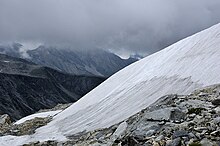Firn (/fɪərn/; from Swiss German firn "last year's", cognate with before) is partially compacted névé, a type of snow that has been left over from past seasons and has been recrystallized into a substance denser than névé. It is ice that is at an intermediate stage between snow and glacial ice.[1] Firn has the appearance of wet sugar, but has a hardness that makes it extremely resistant to shovelling. Its density generally ranges from 0.35 g/cm3 to 0.9 g/cm3,[1][2] and it can often be found underneath the snow that accumulates at the head of a glacier.


Snowflakes are compressed under the weight of the overlying snowpack. Individual crystals near the melting point are semiliquid and slick, allowing them to glide along other crystal planes and to fill in the spaces between them, increasing the ice's density. Where the crystals touch, they bond together, squeezing the air between them to the surface or into bubbles.
In the summer months, the crystal metamorphosis can occur more rapidly because of water percolation between the crystals. By summer's end, the result is firn.[3]
The minimum altitude that firn accumulates on a glacier is called the firn limit, firn line or snowline.
List of firns
editOther uses
editIn colloquial and technical language, "firn" is used to describe certain forms of old snow, including:
- old snowfields, known as Firnfelder (lit. 'firn fields'), even if the snow is not yet one year old
- the more recent snow layers of a temperate, or "firned", glacier
- used in skiing, the uppermost, soft layer of snow that is frozen overnight and, as a result of spring sunshine and high air temperatures, melts and reforms on an area of old snow or harsch (lit. 'harsh', referring to the snow's rough texture)
As in the last context, a ski slope that experiences melting and refreezing into harsch is said to "firn up". In Switzerland, these slopes are called Sulz, but in Germany, Sulz more often refers to a depth at which skiing downhill is no longer enjoyable.
References
edit- ^ a b c van den Broeke, Michiel (1 May 2008). "Depth and Density of the Antarctic Firn Layer". Arctic, Antarctic, and Alpine Research. 40 (2): 432–438. doi:10.1657/1523-0430(07-021)[BROEKE]2.0.CO;2. ISSN 1523-0430. S2CID 198156588.
- ^ Cuffey, Kurt M.; Paterson, W. S. B. (3 May 2010). The Physics of Glaciers (Fourth ed.). Elsevier. ISBN 978-0123694614. LCCN 2009050362.[page needed]
- ^ Hays, Jeffrey. "GLACIERS: TYPES, MECHANICS, DANGERS AND TERMS". factsanddetails.com. Retrieved 2024-01-08.
- ^ Veldhuijsen, Sanne; Van De Berg, Willem Jan; Brils, Max; Kuipers Munneke, Peter; van den Broeke, Michiel (1 December 2021). "Contemporary Characteristics of the Antarctic Firn Layer (1979-2020)". AGU Fall Meeting Abstracts. 2021: C35E–0919. Bibcode:2021AGUFM.C35E0919V.
- ^ "DanielBruun Firn". Mapcarta. Retrieved 31 May 2019.
- ^ "Dreyer Firn". Mapcarta. Retrieved 31 May 2019.
- ^ Sven Hedin Firn, Army Map Service, United States Army Corps of Engineers, Greenland 1:250,000
Sources
edit- "Firn". Encyclopædia Britannica.
- "Fundamentals of Physical Geography". physicalgeography.net.
- Machguth, Horst; MacFerrin, Mike; van As, Dirk; Box, Jason E.; Charalampidis, Charalampos; Colgan, William; Fausto, Robert S.; Meijer, Harro A. J.; Mosley-Thompson, Ellen; van de Wal, Roderik S. W. (April 2016). "Greenland meltwater storage in firn limited by near-surface ice formation" (PDF). Nature Climate Change. 6 (4): 390–393. Bibcode:2016NatCC...6..390M. doi:10.1038/nclimate2899. hdl:1874/335472. S2CID 33914856.
- "USGS Glossary of Selected Glacier and Related Terminology". ulcan.wr.usgs.gov.